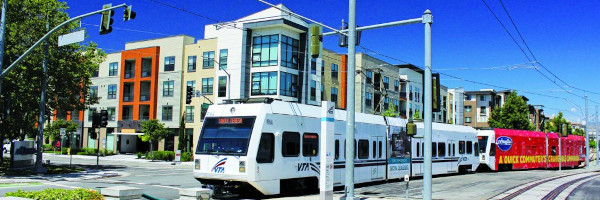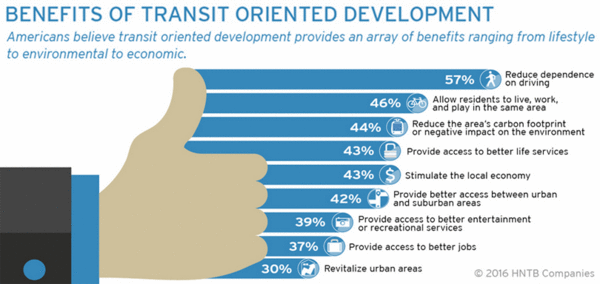Transit-Oriented Development: Difference between revisions
No edit summary |
No edit summary |
||
| Line 18: | Line 18: | ||
'''Economic benefits''': TOD can create significant economic benefits for communities. By increasing access to public transit and creating more walkable and bikeable neighborhoods, TOD can help to reduce transportation costs for residents. This can increase disposable income and boost local economic activity, as residents have more money to spend on other goods and services. Additionally, TOD can create new jobs and increase property values, which can generate tax revenue for local governments. | '''Economic benefits''': TOD can create significant economic benefits for communities. By increasing access to public transit and creating more walkable and bikeable neighborhoods, TOD can help to reduce transportation costs for residents. This can increase disposable income and boost local economic activity, as residents have more money to spend on other goods and services. Additionally, TOD can create new jobs and increase property values, which can generate tax revenue for local governments. | ||
[[File:Benefits of TOD.gif|600px]] | [[File:Benefits of TOD.gif|600px]] | ||
Revision as of 06:14, March 31, 2023
| Transportation | |||||||||||
|---|---|---|---|---|---|---|---|---|---|---|---|

| |||||||||||
| Sectors | Transportation | ||||||||||
| Contact | Wilfred Pinfold | ||||||||||
| Topics |
| ||||||||||
Activities
| |||||||||||
- Authors
Transit Oriented Development (TOD) is a planning and development approach that seeks to create compact, mixed-use, and pedestrian-friendly communities centered around high-quality public transportation. TOD is becoming an increasingly popular urban development strategy in many cities around the world as cities grapple with issues of urban sprawl, traffic congestion, and air pollution. The goals of TOD are to create more sustainable, livable, and vibrant communities that offer residents access to a range of amenities and services within a walkable, transit-oriented environment.
One of the most important benefits of Transit Oriented Development1 is its potential to reduce reliance on cars and improve access to public transportation. By locating new development near transit hubs, TOD can increase transit ridership, which in turn can reduce greenhouse gas emissions, improve air quality, and decrease traffic congestion. Additionally, TOD can help to create more equitable access to transit, providing greater mobility and economic opportunities to low-income communities and other underserved populations.
Another important goal of TOD is to create more livable, walkable, and vibrant neighborhoods. By mixing residential, commercial, and other land uses, TOD can create vibrant, 24/7 communities where residents can live, work, and play in close proximity. This can create a more sense of community and place, and make it easier for residents to access a range of amenities and services within walking distance of their homes.
Overall, Transit Oriented Development is an important strategy for creating more sustainable, livable, and equitable communities. By locating new development near transit, TOD can help reduce car dependence, increase access to transit, and create vibrant and walkable neighborhoods that offer a range of amenities and services.
Benefits
Transit Oriented Development (TOD) offers a range of benefits, including economic, environmental, and social benefits. Here are some more details on each of these:
Economic benefits: TOD can create significant economic benefits for communities. By increasing access to public transit and creating more walkable and bikeable neighborhoods, TOD can help to reduce transportation costs for residents. This can increase disposable income and boost local economic activity, as residents have more money to spend on other goods and services. Additionally, TOD can create new jobs and increase property values, which can generate tax revenue for local governments.
Environmental benefits: TOD can also create important environmental benefits. By reducing car dependence and increasing transit ridership, TOD can help to reduce greenhouse gas emissions, improve air quality, and decrease traffic congestion. Additionally, TOD can help to protect natural resources by reducing urban sprawl and preserving open space.
Social benefits: Finally, TOD can create important social benefits for communities. By creating more walkable and bikeable neighborhoods, TOD can help to promote physical activity and improve public health outcomes. Additionally, TOD can create more equitable access to transit and economic opportunities, helping to reduce social and economic disparities. Finally, TOD can create more vibrant and livable communities, which can help to foster a sense of community and social connectedness.
Overall, Transit Oriented Development offers a range of benefits that can help to create more sustainable, livable, and equitable communities. By creating more compact, mixed-use, and pedestrian-friendly neighborhoods centered around public transit, TOD can help to reduce car dependence, improve environmental outcomes, and create more vibrant and connected communities.
References
- ^ Dittmar, H, et.al.. "The new transit town: Best practices in transit-oriented development". Island Press, 2012, ISBN = 1-55963-117-1, .



